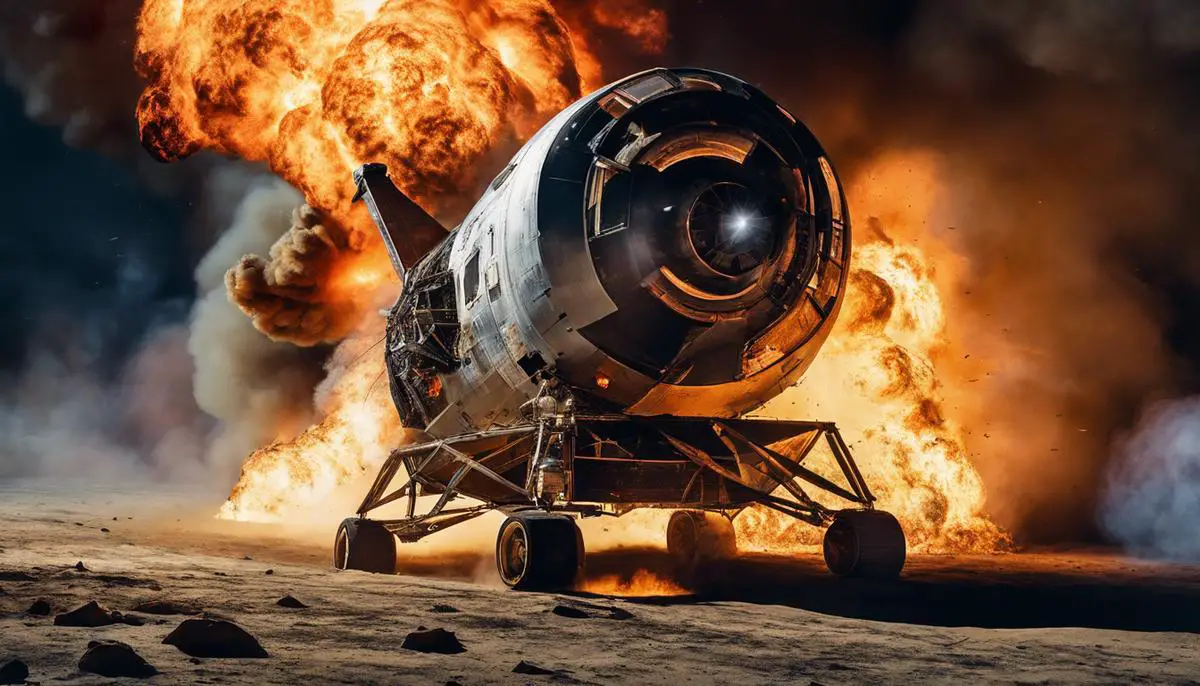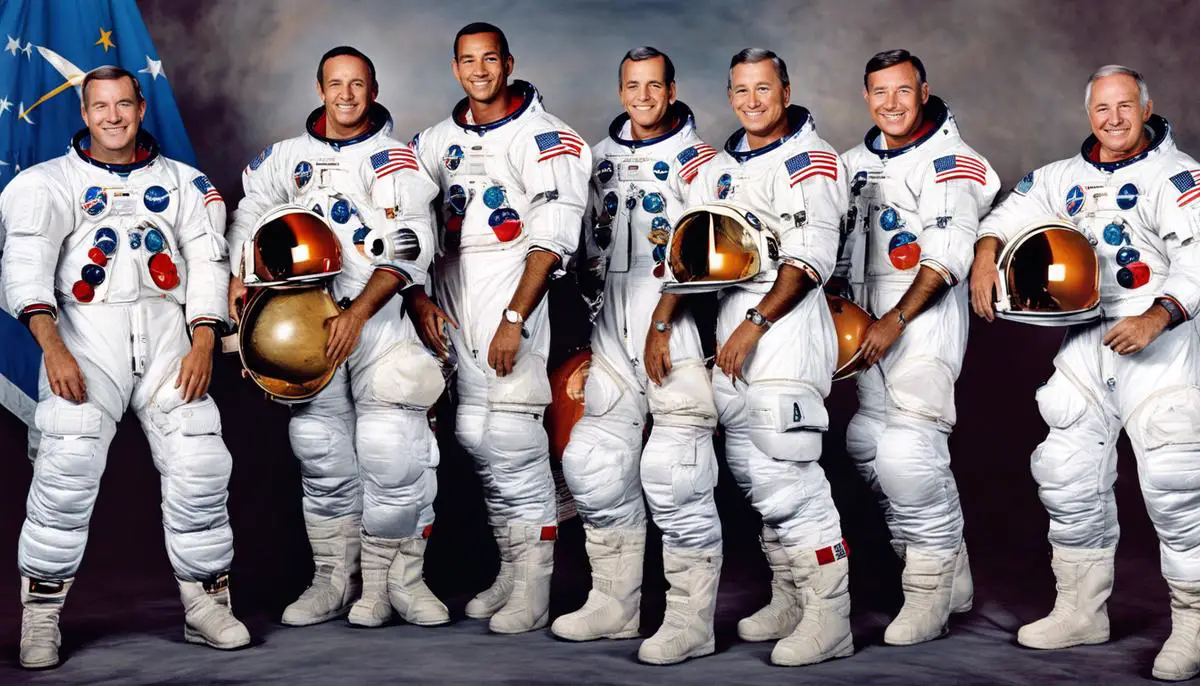The Apollo 1 mission, known initially as ‘AS-204’, represents a poignant page in the annals of space exploration. Programme Apollo sought to accomplish a giant leap for mankind, but the steps leading to it were marked with perils – the most tragic being the catastrophe of Apollo 1, claiming the lives of astronauts: Gus Grissom, Ed White and Roger Chaffee.
In this historical review, we will steer into the lives and careers of these astronauts – who were chosen for this pivotal mission, understand the tragic incident that claimed their lives, and observe the profound effects that rippled through the world of space exploration. Specifically, a closer examination of the systemic shortcomings and design flaws in Apollo 1 will be undertaken, based on evidence and reports from both the past and present.
Contents
Formation of the Apollo 1 Crew
The Apollo 1 Crew: An Examination of Members and Their Selection.
Exemplifying a fascinating intersection of ambition, planning, and technical endeavor, the Apollo 1 mission is one of the remarkable chapters in the annals of space exploration. An intricate understanding of the crew members and the selection process can substantively enhance the comprehension of the mission and its historical significance within the broader context of NASA’s endeavors.
Initiating the roster of the Apollo 1 crew is Virgil I. “Gus” Grissom, a distinguished member of NASA’s second astronaut group. Having demonstrated his proficiency and courage on the Liberty Bell 7 and Gemini 3 missions, this veteran astronaut was deemed a fitting selection. Consistently focused and mission-oriented, Grissom’s military training and previous spaceflight experience positioned him suitably for the Command Pilot role, setting a resolute course for the mission.
Matching the tenacity and competence of Grissom, Edward H. White, an eminent member of the astro group known as “The New Nine”, was appointed to the position of Senior Pilot. The indelible memory of White’s extraordinary extravehicular activity (EVA) during Gemini IV rendered him a solid option for Apollo 1. He was chosen due to his extraordinary technical aptitude, pioneering spirit, and celebrated EVA proficiency.
Assuming the role of Pilot was Roger B. Chaffee, NASA’s third group astronaut. While new to space flight, Chaffee’s exhaustive engineering acumen and unwavering commitment to rigorous training complemented the collective skills of the crew. His excellent understanding of flight system operations, mine, and aerial mapping techniques steered his selection, upholding a blend of novelty and expertise within the group.
The selection process incorporated a holistic evaluation of technical knowledge, physical and mental endurance, adaptability, and team compatibility. In the Apollo program, there was a heightened focus on group dynamics and cohesion given the extended mission duration, leading to an assessment of teamwork and collaboration alongside individual talents and training.
Top-notch skills and depth of spaceflight knowledge were indispensable, resulting in the inclusion of at least one veteran astronaut, a tradition prevalent since Gemini. The mission-specific role requirements also shaped pilot selection, as evidenced by the clear division of responsibilities among the Command Pilot, Senior Pilot, and Pilot roles in the Apollo 1 crew.
To conclude, the Apollo 1 crew selection was a carefully orchestrated process, juxtaposing experiential wisdom and fresh perspectives. Composed of dedicated professionals like Grissom, White, and Chaffee, the Apollo 1 mission exemplifies the relentless pursuit of knowledge and exploration. It underscores how an insightful blend of experience and novelty, underlined by an unwavering focus on group synergy, contributed to an extraordinary chapter of human spaceflight. As such, the Apollo 1 crew story reinforces a tale of remarkable human endeavor, igniting reflective impressions on the ethos of space exploration.

The Tragic Accident of Apollo 1
Turning to the fateful day, January 27, 1967, during a pre-launch simulation, the Apollo 1 spacecraft was positioned on top of a Saturn IB rocket.
The primary objective of this ‘plugs-out’ test was to examine the spacecraft’s systems in a launch-like condition, with both the vehicle and crew operating off their internal power sources.
The Apollo 1 spacecraft was intended to be a brighter, secure beacon in man’s audacious endeavor to conquer space, but it had design flaws that decisively contributed to the impending disaster.
Shielded in an atmosphere of pure oxygen, the internal cabin was a potential tinderbox.
Owing to the high pressure within the crew cabin, it was designed to open outward, thus making it a formidable challenge to open the hatch in an emergency, especially when confronted by the forces exerted from within.
When reviewing the nemesis that ignited the disaster, it becomes evident that the copious amount of flammable materials within the cabin, such as nylon netting and foam pads, played an accessible host to potential fire sources.
Another enhancing factor was the lack of effective emergency procedures to handle unexpected events.
An electrical malfunction is assumed to have been the inception of the calamity. At precisely 6:31 PM, the ground crew lost telemetry with the astronauts who were reporting a fire in the cockpit. The combined forces of fire, heat, and internal pressure of around 17 PSI was a calamity cocktail that resulted in the tragic, explosive demise of the Apollo 1 spacecraft within a mere 20 seconds.
The resultant shockwave of this incident was not only felt at NASA but also resounded globally, prompting myriad inquiries and rigorous investigations into NASA’s safety standards and protocols.
Consequently, modifications were carried out on all hardware, design, and materials, fostering advanced safety measures including the switch to a nitrogen-oxygen mixed atmosphere, safer materials with lesser toxic gases, and an inward-opening redesigned hatch.
However, amidst the tragedy, valuable lessons were acquired that led to the evolution of safer and more effective crewed mission designs.
The loss of Grissom, White, and Chaffee resonates in historical memory and ignites an undying motivation to continue exploring, seeking, and questioning, transforming failures into stepping stones for remarkable future triumphs.
Today, their legacy echoes inside every American spacecraft launched into the cosmos.
The Apollo 1 fire may have burnt three lives to cinders but out of the ashes rose arguably the most formative safety-related propagations in the history of crewed spaceflight.
This edified resilience and passionate resolve not only ensured that their sacrifice was not in vain but it also paved the way for Neil Armstrong’s epochal moon landing on July 20, 1969, where mankind ventured into unprecedented territories beyond the confines of our world.

Aftermath and Impact of Apollo 1
Upon examination of the catastrophe surrounding Apollo 1, the influence it exerted on NASA’s ethos and operations is of paramount importance. The calamity sparked immediate shock and sorrow across the NASA community but was swiftly followed by a deep determination for transformation. The realization of precious lives lost set in motion a chain of introspection and critical changes, shaping the future course of manned spaceflight missions.
The initial response was the formation of the Apollo 204 Accident Review Board on January 28, 1967, instituted to dissect the unfortunate circumstances that resulted in the conflagration. This Board presented exhaustive detail, investigating not just the accident per se but events preceding it, including planning, procedural controls, and testing. The process served as a blueprint for strengthening critical observations, augmented attention to detail, and the absolute necessity of meticulous planning.
The comprehensive review unraveled systemic issues within the spacecraft construction process, and governance within NASA itself. Safety standards heretofore accepted were questioned rigorously. Resultant modifications within the agency encompassed the administrative echelon, processes, and human resources, augmenting the incorporation of engineers and safety officers into the decision-making process. Revisions extended to the very fabric of spacecraft design and overall safety approach — a resolute shift from designing systems merely to prevent failure towards a comprehensive focus on fail-safe systems.
In early 1967, the Manned Spacecraft Center (renamed Johnson Space Center in 1973) organized the Apollo Spacecraft Program Office (ASPO). This unit revolutionalized the Apollo program’s management. The initiative included weekly Configuration Control Board (CCB) meetings, ensuring that necessary changes were engineered with utmost proficiency without compromising safety.
Parallel to administrative and procedural modifications, technological enhancements were undertaken. NASA standardized the use of non-flammable materials in constructing space suits, crew cabins, and components. Missteps in the design of Apollo 1 spacecraft, such as a hatch that opened inward, making it virtually inoperable in an emergency, were corrected. Consequently, hatches in future Apollo missions and succeeding spacecrafts for manned missions were modified to open outward for expeditious exit during emergencies. Emergency egress procedures were re-evaluated and improved training was deployed for crew and support personnel.
The Apollo 1 tragedy instigated an uncompromising adoption of a “failure is not an option” mantra within NASA, fostering an unwavering commitment to the safety of crew members. Post-Apollo 1 procedures exhibited the incorporation of safety reviews at every stage of a mission – including the design, building, and testing of spacecrafts. This relentless pursuit of safety also sanctioned successful subsequent missions, a testament signified by Neil Armstrong’s triumphant declaration on July 20, 1969: “That’s one small step for man, one giant leap for mankind.”
In conclusion, the poignant incident associated with Apollo I elicited a profound evolution within NASA, amplifying safety protocols and expectations. It impelled transformative lessons that reframed astronaut safety, redefined protocols, and led to the birth of a stronger, more determined community poised for higher achievements. Today, the legacy of the Apollo 1 astronauts persists in NASA’s relentless striving to ensure safety for all crew members venturing into the infinite terrains of space. Their sacrifice continuously emphasizes the invaluable ethos: vigilance and safe exploration are paramount in the journey through the cosmos.

The Apollo 1 mission, despite its horrific outcome, marks a significant turning point in the technological and safety advances of space missions. It served as a grim reminder of the dangers involved in venturing beyond our planet and spurred necessary changes in design and safety protocols.
The lives lost in the Apollo 1 accident echoed throughout the global aerospace community, fostering a heightened awareness and dedication towards safety that was deeply stamped in NASA’s subsequent missions. While the incident was a tragic setback, the lessons learned have played an instrumental role in shaping safer and more successful space travels.
